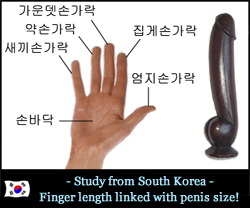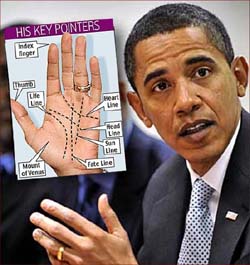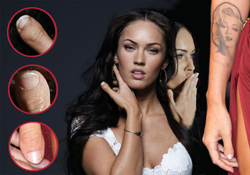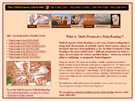HANDS & DOWN SYNDROME – A Simian Crease Poll!
May 15, 2011

The BabyCenter.com has conducted a simian crease poll among parents of children who have Down syndrome.
The result confirms the significance of the simian line in Down syndrome, because 41 of the 95 participants (=43%) reported that their child has Down’s syndrome.
But the diagnostic signficance of a simian crease (simian line) is unspecific. Despite the fact that the simian crease is well-known for it’s significance in children & adults who have Down syndrome – there are quite a few other syndromes which show even higher percentages regarding the occurence of the simian crease, such as: the cat-cry syndrome, Edwards syndrome, Patau syndrome, and Cornelia de Lange syndrome.
The most common synonyms for the simian crease are: simian line, single transverse crease, single palmar crease
Read more about the role of the simian crease in Multi-Perspective Palm Reading:
http://www.multiperspectivepalmreading.com/palm-reading-hand-creases-major-lines.htm

What discriminates ‘Multi-Perspective Palm Reading’ from all other approaches in the field of hand reading?
Multi-Perspective Palm Reading is a new type of hand reading that is rising from scientific research reports that relate to the hand as a ‘diagnostic tool’. The unique characteristic of this advanced type of palm reading is that it only includes hand markers which have been confirmed to have significant value according scientific studies. So this NEXT NATURE variant of ‘palmistry’ is not connected anyhow with astrology nor any other philosophic system.
In Multi-Perspective Palm Reading is the hand studied from 7 different perspectives in order to make an assessment for various specified themes – which can result in either a confirming- or prognostic ‘hand-diagnosis’.
The philosophy behind Multi-Perspective Palm Reading:
The philosophy behind this new advanced type of hand reading can be described as follows:
“In Multi-Perspective Palm Reading, a reliable hand-diagnosis is only possible when a pair of hands displays ‘diagnostic clues’ in MULTIPLE perspectives of the hand. According Multi-Perspective Palm Reading a person typically requires to have ‘diagnostic clues’ in at least 3 perspectives of his/her hands, before one can speak of a solid, specified hand-diagnosis.
The application of this philosophy in the practice for making a hand assessment can be understood by studying the role of the simian line in hand diagnostics. In the 20th century the simian line (the most well known of all palm line variations: a.k.a. the single palmar transverse crease or simian crease) became known as a diagnostic marker for Down syndrome. However, during the past decades this uncommon hand marker was recognized as a ‘minor physical anomaly’ that has diagnostic value for other syndromes, diseases & developmental problems. But in order to specify it’s significance as a major hand line for the individual that has this characteristic in one or both hands, a study of the other perspectives of the hand is required!
The 7 perspectives used in Multi-Perspective Palm Reading:
In the following seven perspectives are required to be studied in order to make a thorough hand assessment:
1 – Palm Reading & the HAND SHAPE, including e.g.: hand index, palm shape, hand length, hand breath.
2 – Palm Reading & the FINGERNAILS, including e.g.: color, morphology, structure, growth.
3 – Palm Reading & FINGER MORPHOLOGY, including e.g.: finger length, 2D:4D ratio, variations in shape & width.
4 – Palm Reading & the MAJOR LINES, including e.g.: primary creases, secundary creases, tertairy creases & accessory lines.
5 – Palm Reading & the DERMATOGLYPHICS, including e.g.: fingerprints, palmar dermatoglyphics.
6 – Palm Reading & SKIN QUALITY, including e.g.: colour, structure, flexure / tone.
7 – Palm Reading & HAND MOTORICS, including e.g.: flexibility, motoric hand index.
Read more about how Multi-Perspective Palm Reading varies from other types of hand reading & modern palmistry via the Wikipedia section: Modern Palmistry: science & criticism

A ‘family tree’ of the palmar lines!
September 4, 2010

In 2004 Chinese researchers present a new approach to study the hand lines for biometric purposes. They applied a mathematical model on hand prints and were able to identify six types of palmar crease variations – based on the core characteristics of the three ‘major palmar lines’. Recently, in line with the Chinese research a new more advanced (PIC) model was introduced which e.g. describes 21 types of major hand line variations which are displayed in ‘a family tree of the major hand line types’: see the picture above.
Interestingly, the new study reports e.g. about a correlation between the palmar lines and intelligence (IQ): left hand vs. right hand asymmetries appear to be involved, plus a lower prevalence of MPA’s – such as the simian line & Sydney line).
More details are available in the article:
What can formations in hand lines reveal?
For more information about various aspects of the palmar lines the following book is recommended:
‘Anthropology of Crease Morphogenesis’.
NOTICE: The three major palmar lines concern:
– The ‘radial longitudinal crease’, in palmistry a.k.a. the ‘life line’;
– The ‘distal transversal crease’, in palmistry a.k.a. the ‘heart line’;
– The ‘proximal transveral crease’, in palmistry a.k.a. the ‘head line’.
Related news reports & articles are available at:
News about the palmar creases / hand lines.
NEW BORN BABY TEST: ‘The hand check!’
June 17, 2010

[tweetmeme source=”handresearch” only_single=false] In the hours after a baby is born, the baby will have several tests and examinations to check that he is healthy and well. Knowing what the doctors are looking for will put your mind at rest and give you the opportunity to ask any questions you might have. What is included in the ‘new born baby hand test’? NEW BORN BABY HAND TEST: “The baby’s arms, hands, legs and feet will be checked. The fingers and toes are counted to make sure they are all there and to check for webbing (syndactyly). The hand palms will be checked for two palmar creases; a single palmar creases (a.k.a. simian line) is less common, however 4 per cent of the population have one palmar crease on one hand and 1 per cent have one palmar crease on both hands. This is sometimes associated with Down’s syndrome but in the unlikely event of your baby being affected there would be other hand signs, such as the ‘high positioned axial triradius’.” SUGGESTIONS FOR FURTHER READING: |
FRAGILE X SYNDROME – 28 Hand characteristics in the genetic syndrome variant of autism!
February 22, 2010

Phantom picture of the hand in Fragile X syndrome! In 1986 A. Rodewald et al. presented the first ‘phantom picture’ describing the typical hand characteristics in Fragile X syndrome (e.g. hand calluses & flexible finger phalange joints). But more detailed ‘phantom pictures’ were never presented since then. This month (february 2010) a more detailed updated version of the visualisation became available – featuring 28 characteristics of the hand in Fragile’s syndrome! What are the most common hand characteristics in Fragile X syndrome? HAND LINES: DERMATOGLYPHICS: HAND SHAPE: NOTICE: The author of the new ‘phantom picture’ for Fragilex syndrome described a specific guideline which states that in most cases of Fragile X syndrome certain combinations of the 28 characteristics are found in both the fingers AND the palm of the hand! More details available at: Photo: example of a baby hand with hyperextensible finger joints – a common feature in Fragile X syndrome. |
  
• Tribute to the hands of Thom Yorke! Thom Yorke thumbs & the simian line… The simian line (a.k.a. ‘simian crease’) is the most studied line of the human hand. Despite it’s associations with Down syndrome (+ a rainbow of other medical problems), quite a few famous people have the simian line. Radiohead’s leadsinger Thom York has a variant of the classic simian line in his right hand – an ‘incomplete simian crease‘. What do we know about the most ‘notorious’ of all hand lines? Having a simian line is not very uncommon at all: about 2% to 4% of the population has this rather remarkable hand line – though in Asia the percentages are higher up to above 10% in Chinese people. Rather remarkable – despite the strong links with various medical problems – some believe that the simian line can also be recognized as a ‘gift marker‘ which could relate to strong personality characteristics that bring stamina, intensity and strong concentration. More Thom Yorke thumbs of his simian line:
– MORE FAMOUS HANDS & THUMBS – Another fascinating characteristic of the hands of Thom Yorke concerns his fingerlength: his ring finger is much longer than his pointer finger. Interestingly the long ring finger has historically been associated with musical abilities. Professor John Manning (Liverpool University) presented in 2000 a study which pointed out that the hands of male symphony musicians are characterised with a likewise combination: the low ‘digit ratio’ – of 2D:4D finger ratio (2D = index finger; 4D = ring finger). Quote from Professor John T. Manning’s book ‘digit ratio’ (page 121):
By the way, extreme digit ratios (finger lengths) are – just like the ‘simian crease’ (Thom Yorke) and the ‘clubbed thumb’ (Megan Fox) – recognized as a ‘minor physical anomaly’ (MPA). SUGGESTION FOR FURTHER READING: |
DOWN SYNDROME – 27 Characteristics of the hand in trisomy 21!
January 19, 2010

Phantom picture of the hand in Down syndrome! In 1963 L.S. Penrose presented the first ‘phantom picture’ describing the typical hand characteristics in Down syndrome. More detailed ‘phantom pictures’ were presented by Schaumann & Alter (1976), Rodewald (1981). This month (2010) a more detailed updated version of the visualisation became available – featuring 27 characteristics of the hand in Down’s syndrome! What are the most common hand characteristics in Down syndrome? HAND LINES: DERMATOGLYPHICS: HAND SHAPE: NOTICE: The author of the new ‘phantom picture’ for Down syndrome described a specific guideline which states that in all cases of Down syndrome certain combinations of the 27 characteristics are found in both the fingers AND the palm of the hand! More details available at: Photo: example of a baby hand in Down syndrome
|
 Primate hands: the hand of a macaque! |
‘Whorls’ are a common features in the hands of many primate species!
What are the major differences between the hands of primate species and the human? • 1 – Primates usually have a shorter thumb than humans – the thumb of the macaque (see photo on the left) does not rearch out behond the distal border of the handpalm. • 2 – Primates usually have a lower ‘2D:4D digit ratio’ than humans – the hand of the macaque is featured with a much longer ring finger (digit 4) than the pointer finger (digit 2). |
| • 3 – Primates usually have more fingerprint- and palmar whorls than humans – the hand of the macaque is featured with 5 palmar whorls.
• 4 – Primates always have a lower ‘ridge density’ than humans. • 5 – Primates usually have (various) palmar transversal creases, a.k.a. ‘simian lines’ – the hand of the macaque has one ‘simian line’. SUGGESTIONS FOR FURTHER READING: PHOTO: Impression from the back of the hand of a macaque: |


 “Sorell (1968) pointed out that musical ability has been linked with very long ring fingers for many years. He illustrated this with handprints from composers such as Alexander Tcherpenin and Edgar Varese, but the most powerful image he showed in this context was that of a cast of
“Sorell (1968) pointed out that musical ability has been linked with very long ring fingers for many years. He illustrated this with handprints from composers such as Alexander Tcherpenin and Edgar Varese, but the most powerful image he showed in this context was that of a cast of 


 Finger length & penis size linked!
Finger length & penis size linked! The hands of Barack Obama
The hands of Barack Obama Megan Fox thumbs – TRIBUTE
Megan Fox thumbs – TRIBUTE Hrithik Roshan thumbs – TRIBUTE
Hrithik Roshan thumbs – TRIBUTE Hand Reading Research!
Hand Reading Research! MultiPerspective Palm Reading
MultiPerspective Palm Reading